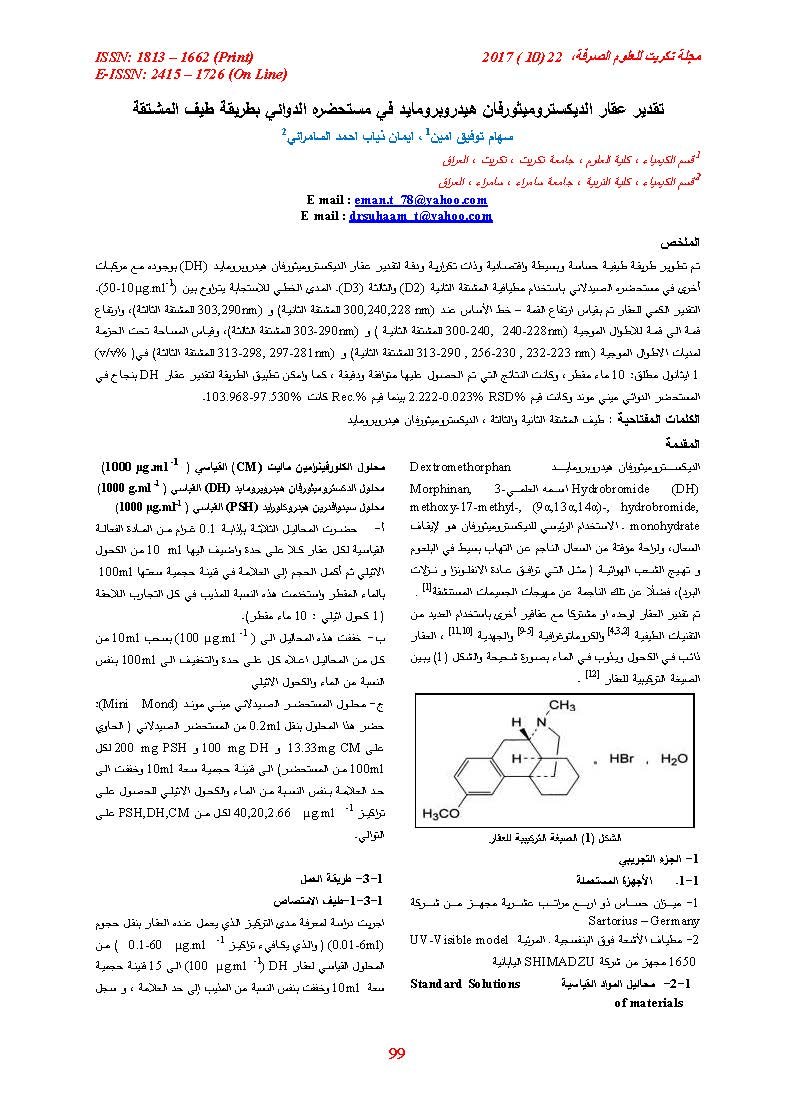Determination of Dextromethorphan Hydreobromide in pharmaceutical preparation using derivative spectrophotometric method
Main Article Content
Abstract
A simple, sensitive, economic, accurate and precise second (D2) and third (D3) derivative spectrophotometric method has been developed for determination of Dextromethorphan hydrobromide in pharmaceutical preparation. The method obeys Beer’s Law in concentration range of 10-50μg/ml employed for evaluation . The quantitative determination of the drug was carried out using the second and third derivative values by measuring ; peak to base line at (300 nm ,240 nm and 228 nm for second derivative) and (303 nm, and 290 nm for third derivative) , peak to peak at ( 300 nm – 240 nm, 240nm – 228nm for second derivative) and (303 nm-290 nm for third derivative) and peak area at (313 nm – 290 nm, 256 nm – 230 nm and 232nm -223nm for second derivative) and at (313 nm -298 nm and 297 nm – 281 nm for third derivative) in 1:10% absolute ethanol: distal water . The results of analysis were validated by recovery studies . The recovery and RSD values was (103.968-97.530 %) and (2.222 – 0.023 %) respectively . The proposed method was applied on syrup formulation (Mini Mond ) .
Article Details

This work is licensed under a Creative Commons Attribution 4.0 International License.
Tikrit Journal of Pure Science is licensed under the Creative Commons Attribution 4.0 International License, which allows users to copy, create extracts, abstracts, and new works from the article, alter and revise the article, and make commercial use of the article (including reuse and/or resale of the article by commercial entities), provided the user gives appropriate credit (with a link to the formal publication through the relevant DOI), provides a link to the license, indicates if changes were made, and the licensor is not represented as endorsing the use made of the work. The authors hold the copyright for their published work on the Tikrit J. Pure Sci. website, while Tikrit J. Pure Sci. is responsible for appreciate citation of their work, which is released under CC-BY-4.0, enabling the unrestricted use, distribution, and reproduction of an article in any medium, provided that the original work is properly cited.
References
1- M. Malladi, R. Jukanti, R. Nair, S. Wagh, S.
Padakanti , and A., Acta Pharm. : 60 (2010) 267–280.
2- J.Pritam, S. Hardik, L. Tulsidas, S.and Sanjay, J.
Pharm. BioSci. : 2(2014) 58-62
3- T. Krunali, P. Vijya, M..Rohit, and DB. Meshram,
IJPCS : 2 (2013) 4,1961-1964
4- R. Vijalakshmi, S. Bhargavi, and M. D. Dhanaraju,
E-Journal of Chemistry : 7(2010) S1, S314-S318 .
5- Z.A. Chaudhary, and J, Derasari , IBDR: 4(2014)
7, 66-83.
6 - H.AL-Akraa, N. Sarkis and M. ALShehaby, Int J
Pharm Pharm Sci: 5 (2013) 4,234-241 .
7- P.G. Bhortake, and, R.S. Lokhande, IJPRR: 3
(2014): 9, 9-14 .
8- D. Varasala, and S. Konidala, Der Pharmacia
Lettre : 7(2015) 2, 112-118 .
9- V.Jain and M.Sharma, JTUSCI :10(2106) 1,38-45 .
10, A.S Amin and M.A Elmosallamy, Anal Sci.: 30
(2014) 3, 419-25.
11- J.I. Al-Mustafa, M.A. Abu-Dalo, and N.S.
Nassory, Int. J. Electrochem. Sci.: 9 (2014) 292 - 303.
12- European Medicines Agency, EMA/ CHMP/
80029/ 2013, Committee for Medicinal Products for
Human Use (CHMP), (2013) p-8 .
13- B. Chakraborthy, L. Sivasubramanian, and
Anusha, Int J Pharm Pharm Sci.: 6(2014) 4, 291.
15- V. V. Khanvilkar and R. R. Kothekar, Int. J.
Pharm. Sci. Drug Res :8(2016)3, 170-173.
16- K. D. Khalode, S. B. Waikar and S. P. Padmane,
IJPT :4(2012)3, 4690-4699 .
